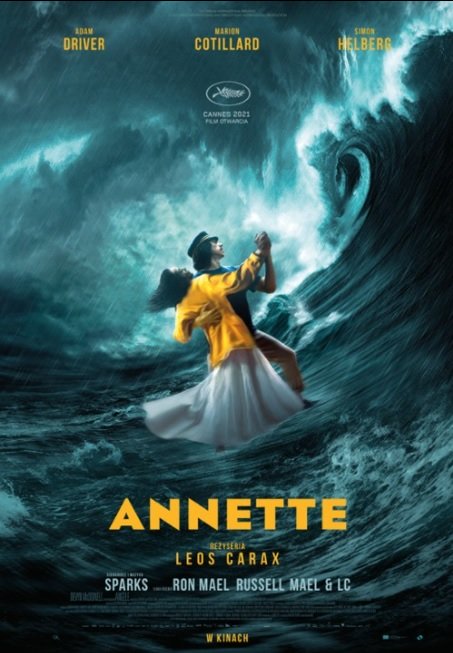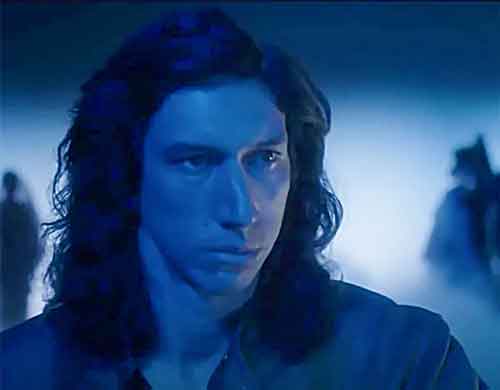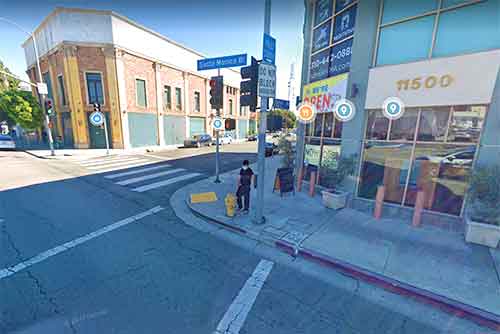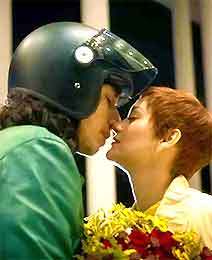 The most sublimely nutty movie musical in some time, featuring songs performed by non-singer actors and a puppet. It’s the first English language film by France’s wildly iconoclastic Leos Carax, which explains the freewheeling invention that pervades ANNETTE. It’s a stand out amid quirky post-2000 musicals, which tend to be excessively self-important (DANCER IN THE DARK) or strain too hard for cult legitimacy (REPO! THE GENETIC OPERA). ANNETTE, by contrast, is defiantly unique and authentically demented.
The most sublimely nutty movie musical in some time, featuring songs performed by non-singer actors and a puppet. It’s the first English language film by France’s wildly iconoclastic Leos Carax, which explains the freewheeling invention that pervades ANNETTE. It’s a stand out amid quirky post-2000 musicals, which tend to be excessively self-important (DANCER IN THE DARK) or strain too hard for cult legitimacy (REPO! THE GENETIC OPERA). ANNETTE, by contrast, is defiantly unique and authentically demented.
The musical overlay is appropriate, as all of Carax’s films are musicals in their way, each bearing a dance interlude (with Carax’s BAD BLOOD containing the cinema’s best use of David Bowie’s “Modern Love”). Unlike most of Carax’s previous films ANNETTE has a (mostly) coherent narrative, bequeathed by a rock opera by the pop duo Sparks (consisting of Ron and Russell Mael, who previously had a song played in Carax’s HOLY MOTORS).
As the film begins it seems like an eccentric love story, with the participants being Henry McHenry, a shitheel who’s become successful through offensive comedy shows, and Ann Desfranoux, an opera diva. Their feelings for each other are summed up by the oft-repeated lyrics of a duet they sing early on: “We love each other so much.” But it seems Ann is having an affair with her much younger conductor and Henry is dissatisfied. Not even the addition of a child they naanneme Annette, who happens to be a wooden puppet a la Pinocchio, suffices to spice things up, and Henry, after shocking the audience at one of his comedy shows by claiming to have killed Ann, does just that on the deck of a cruise ship.
An unexpected—for both Henry and the viewer—development is the fact that Annette is revealed to have an angelic singing voice. Henry decides to exploit this talent, turning baby Annette into a singing sensation with the help of Anne’s conductor boyfriend, but the latter, who may be Annette’s true father, ends up killed by Henry. This precipitates a climactic confrontation between Annette and her father in which the Pinocchio comparison becomes quite apropos.
 The music of this film is quite strong, mixing symphonic tones with more intimate guitar riffs and lyrics that are quite (intentionally) repetitive (with “Shall we Start?” and “We Love Annette” being especially popular refrains). Carax’s choreography of the songs is straightforward and unaffected; he tends to favor naturalism in his performers, and the same is true of his singing and dancing scenes, which are performed while walking, swimming and, in one scene, during oral sex. The effect isn’t as off-putting as it might sound, with the major problem being that, simply, the film’s best musical number is its first, involving the cast strutting down Santa Monica Boulevard (see below: the only scene in an LA set film that actually takes place therein), which has an exuberance and visual panache the rest of the film never matches.
The music of this film is quite strong, mixing symphonic tones with more intimate guitar riffs and lyrics that are quite (intentionally) repetitive (with “Shall we Start?” and “We Love Annette” being especially popular refrains). Carax’s choreography of the songs is straightforward and unaffected; he tends to favor naturalism in his performers, and the same is true of his singing and dancing scenes, which are performed while walking, swimming and, in one scene, during oral sex. The effect isn’t as off-putting as it might sound, with the major problem being that, simply, the film’s best musical number is its first, involving the cast strutting down Santa Monica Boulevard (see below: the only scene in an LA set film that actually takes place therein), which has an exuberance and visual panache the rest of the film never matches.
 Regarding the rest of the film, it’s a fascinating, if uneven, watch. Adam Driver is quite dangerously charismatic as Henry McHenry, while Marion Cotillard as Ann doesn’t have enough screen time to fully register (with her role mostly consisting of her lounging around in various leg-bearing outfits) and THE BIG BANG THEORY’S Simon Helberg makes a surprisingly strong impression as the unnamed conductor. The most prominent performer after Driver is the puppet who plays Annette for most of the film (replaced in the final scenes by Devyn McDowell).
Regarding the rest of the film, it’s a fascinating, if uneven, watch. Adam Driver is quite dangerously charismatic as Henry McHenry, while Marion Cotillard as Ann doesn’t have enough screen time to fully register (with her role mostly consisting of her lounging around in various leg-bearing outfits) and THE BIG BANG THEORY’S Simon Helberg makes a surprisingly strong impression as the unnamed conductor. The most prominent performer after Driver is the puppet who plays Annette for most of the film (replaced in the final scenes by Devyn McDowell).
 The idea of depicting the title character as a puppet (which none of the characters seem to notice), is questionable, although as the film advances the sight of Annette becomes increasingly palatable. The problem is the character, in both voice and appearance, is never as charismatic or endearing as it’s supposed to be. One can only imagine what filmmaker/animator Jan Svankmajer, arguably the cinema’s premiere post-Jim Henson master of puppetry, might have done with ANNETTE.
The idea of depicting the title character as a puppet (which none of the characters seem to notice), is questionable, although as the film advances the sight of Annette becomes increasingly palatable. The problem is the character, in both voice and appearance, is never as charismatic or endearing as it’s supposed to be. One can only imagine what filmmaker/animator Jan Svankmajer, arguably the cinema’s premiere post-Jim Henson master of puppetry, might have done with ANNETTE.
Vital Statistics
ANNETTE
CG Cinema/ARTE/Amazon Studios
Director: Leos Carax
Producers: Paul-Dominique Win Vacharasinthu, Charles Gillibert, Adam Driver
Screenplay: Ron Mael, Russell Mael
Cinematography: Caroline Champetier
Editing: Nelly Quettier
Cast: Adam Driver, Marion Cotillard, Simon Helberg, Devyn McDowell, Sinay Bavurhe, Franziska Grohmann, Rachel Mulowayi, Christiane Tchouhan, Iman Europe, Lauren Evans, Cindy Almouzni, Danielle Withers
